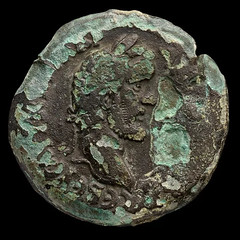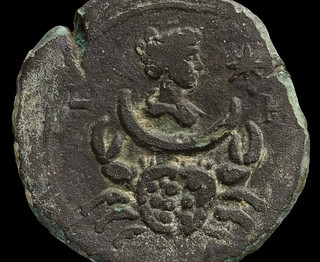
PREV ARTICLE
NEXT ARTICLE
FULL ISSUE
PREV FULL ISSUE
V25 2022 INDEX E-SYLUM ARCHIVE ARCHAEOLOGISTS FIND RARE ZODIAC COINDavid Pickup passed along this Haaretz article about the find of a rare "zodiac" coin. -Editor A beautiful bronze coin almost 2,000 years old has been rescued from the depths of the Mediterranean off Israel during an underwater archaeological survey, the Israel Antiquities Authority announced on Monday. The coin shows the emperor on one side, as befits coinage of the time, and Cancer, the crab sign of the zodiac and a lady on the other – interpreted as the moon goddess Luna.
The crab coin bears the date
Cancer is Latin for Scholars think that astrology, the pseudoscience of mundane divination, may have originated in Sumeria around 5,000 years ago, though there is clearer evidence for early zodiac belief in Babylon almost 4,000 years ago. Others suspect the belief originated in China, or ancient Egypt or Greece; maybe astrology spontaneously developed, much like agriculture, in different places at different times for different reasons. Back to the coin, which clearly shows the crab: its arthropodan eyes on stalks, the right number of legs, its pincers in position seemingly holding up a half-crescent, above which we see the profile of Luna, and a star.
The other side shows the profile of the Gaul-born Emperor Antoninus Pius, one of the so-called
To read the complete article, see:
Thanks also to Aaron Oppenheim, Arthur Shippee, Howard Berlin, Peter Huntoon and others for passing along related articles. -Editor
To read the complete articles, see:
Wayne Homren, Editor The Numismatic Bibliomania Society is a non-profit organization promoting numismatic literature. See our web site at coinbooks.org. To submit items for publication in The E-Sylum, write to the Editor at this address: whomren@gmail.com To subscribe go to: https://my.binhost.com/lists/listinfo/esylum All Rights Reserved. NBS Home Page Contact the NBS webmaster 
|


